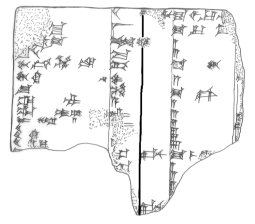Kassite Lexical Texts
Kassite lexical texts continue Old Babylonian traditions with compositions such as the thematic list Ura and the sign list Ea. We also find new compilations, including the very learned series Erimhuš and the more than 50-tablet long series Nabnītu. Exercise tablets from the period contain brief extracts, (school texts), frequently taken from Ura. Larger multi-column tablets are known, too, but since lexical tablets are rarely dated, the attribution to the Kassite period is usually based primarily on paleographic grounds. The largest group of Kassite lexical texts comes from Nippur and is not associated with useful archaeological information. In many cases, therefore, the dating of lexical tablets included in CKST remains uncertain.
In the Kassite period, several of the traditional Old Babylonian lexical compositions have become lexical series in their final or near-final form. Kassite exemplars of the list of compound signs Diri and the sign list Ea suggest that the first millennium format and organization of these series, in seven and eight chapters, respectively, was basically in place. Similarly, the god list An = Anum, which had a one-column Old Babylonian forerunner (TCL 15, 10), is now known in its two-column explanatory format in seven tablets, organized around divine families. Kassite An = Anum is not identical with later versions, but the organization of the material is basically there—the differences are in the details. New lexical series, such as Nabnītu (in perhaps fifty-four tablets) and Erimhuš (in seven) may have been more or less standardized from the outset.
One important new role of the lexical corpus is to give access to the rich possibilities afforded by Sumerian – Akkadian bilingualism for academic subtleties, implausible writings and unexpected lexemes. The organization of the list Nabnītu according to the activities of the human body from head to toe, may well have facilitated such access, in particular the access to rare Sumerian words.
Despite the fact that the Kassite period was long and has yielded large numbers of tablets, the evidence for the literary and scholarly history of the period is rather meagre and we have to reconstruct a vibrant intellectual life from little bits and pieces. The extant corpus of Kassite lexical tablets is relatively small but bears witness to a much larger and richer tradition that must have existed. This lexical tradition was used for scribal education, but also for transmitting and composing Sumerian texts; both literary texts and royal inscriptions.

Drawing of CBS 13924 with various conventions typical for Kassite-period lexical texts.
Multi-column lexical tablets from the Kassite period use conventions that are rare or absent in other periods. Bilingual (Sumerian - Akkadian) lists may leave the Akkadian column blank for words that occurred earlier in the list or where the translation seems obvious; see,for instance, the list of domestic animals SLT 44. Since this list repeats the same set of qualifications for sheep, cows, goats, etc., much of the Akkadian column is uninscribed.
Where the same Akkadian translation has to be repeated several times in a row, Kassite (and Middle Assyrian) period texts tend to use numerals: 2, 3, 4, 5, 6, etc. for the second, third, fourth, fifth and sixth repetition of the Akkadian word. First millennium texts, by contrast, simply repeat the signs MIN or KI.MIN (for ditto) as many times as necessary. A feature of layout that may indicate a Kassite dating is the use of shallow vertical lines for the correct placement of signs within a column. Such vertical rulings within a column are also widely used in contemporary Hattuša, Emar and Ugarit. Finally, some Kassite-period lexical texts include section totals, which indicate the number of lines within a section. Sections are demarcated by horizontal rulings; the section total is written in small numerals just above the ruling. Repetition by numbers, shallow vertical rulings, and section totals are all exemplified in CBS 13924, a copy of Nabnītu 21.
27 Dec 2019Further reading
- Veldhuis, Niek C. 2000 Kassite Exercises: Literary and Lexical Extracts. Journal of Cuneiform Studies 52: 67-94. Download [http://www.jstor.org/stable/1359687] from JSTOR (subscription required).
Niek Veldhuis
Niek Veldhuis, 'Kassite Lexical Texts', Corpus of Kassite Sumerian Texts, The ckst Project, 2019 [http://oracc.org/introduction/lexicaltexts/]